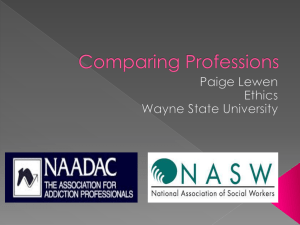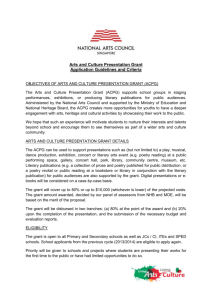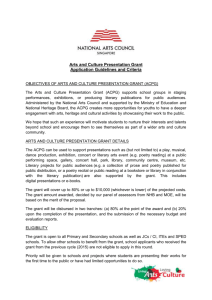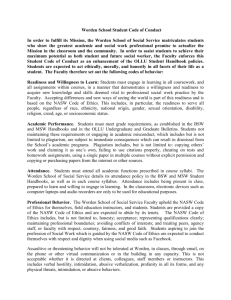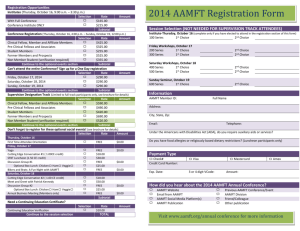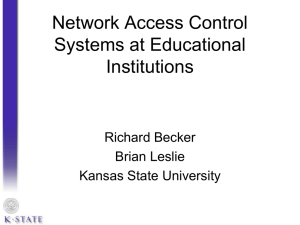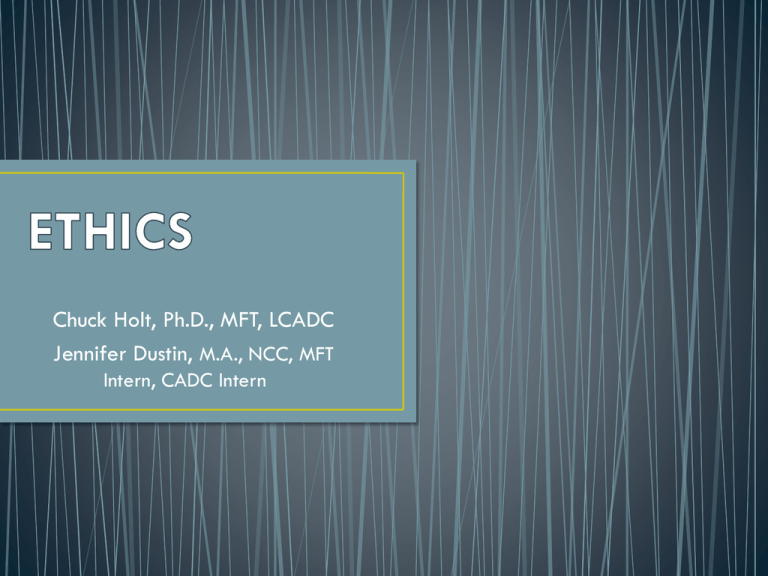
Chuck Holt, Ph.D., MFT, LCADC
Jennifer Dustin, M.A., NCC, MFT
Intern, CADC Intern
“[Ethics] grades from a consciousness of a duty
nearly as strong as positive law, to a feeling that the
matter is all but a question of personal choice. . . .
[It] is the domain of obedience to the
unenforceable. That obedience is the obedience of
a man to that which he cannot be forced to obey.
He is the enforcer of the law upon himself.”
-John Fletcher Moulton, 1924
NAADAC:
http://www.naadac.o
rg/resources/185pr11
AAMFT:
http://www.aamft.org
/imis15/content/legal
_ethics/code_of_ethic
s.aspx
NASW:
http://www.socialwor
kers.org/pubs/code/c
ode.asp
NAC 641C (for CADC/ LADC/LCADC):
http://www.leg.state.nv.us/nac/nac-641c.html#NAC641CSec400
NAC 641A (for MFT/ CPC): http://www.leg.state.nv.us/NAC/NAC641a.html#NAC641ASec243
NAC 641B (for MSW): http://www.leg.state.nv.us/nac/NAC641B.html#NAC641BSec200
What if the
ethical codes
and statutes
differ??
-- Does law trump ethics?
--The safest bet is to go with
whichever is more stringent.
Bruff v. North Mississippi Health Services, Inc. (2001)
Bruff made clear to her employer (an EAP) that she was unwilling to provide
counseling to clients in any area which conflicted with her religious beliefs.
Bruff was ultimately terminated after having been provided due process by
the EAP; she filed a federal suit on the grounds of discrimination.
The court determined that an employer is not mandated to adapt to such
rigidity, and took a stance on the potential harm to clients.
Ward v. Eastern Michigan University (2010)
Grad student dismissed from program due to refusing to treat a same-sex
couple, citing a religious conflict.
The court sided with EMU due to the clarity of university policy against
discrimination, and the programs stated incorporation of ACA / CACREP
standards.
Keeton v. Augusta State University (2010)
Grad student made anti-gay statements in class.
Refused remediation plan, which intended to increase her clinical ability to
treat clients without imposing personal values (NOT to change her mind…)
• Ethical code violations occur in each case, and the judgments
have been in favor of the institutions’ obligation to those codes.
• ACA (2005) asserts that counselors must do no harm (A.4.a.) and take
steps to avoid imposing their own values on clients (A.4.b.).
• Additionally, “Counselors do not condone or engage in discrimination
based on age, culture, disability, ethnicity, race, religion/spirituality,
gender, gender identity, sexual orientation, marital status/partnership,
language preference, socioeconomic status, or any basis proscribedby
law” (C.5., p.10).
• These cases all referred to ACA, however other codes reflect
similar philosophies.
• NAADAC principles: 1 (nondiscrimination), 8 (preventing harm), and 9
(duties of care)
• AAMFT principles: 1.1 (nondiscrimination), 1.8 (respect clients’ rights to
make life decisions)
• NASW sections: 1.01 (commitment to clients),1.05 (cultural competence
and social diversity)
Traditional ideas of a
boundary
A line to be crossed… one
side is acceptable, and the
other is…??
Crossing vs. Violating
What’s the difference?
Motives, behaviors,
therapeutic considerations
THE HIGHWAY METAPHOR – Rules of the road
THE BRIDGE METAPHOR – Two sides finding a
way to connect
THE TERRITORY METAPHOR – A mutually
agreed upon meeting space
* Austin, W., Bergum, V., Nuttgens, S., & Peternelj-Taylor, C. (2006). A re-visioning of boundaries in
helping relationships: Exploring other metaphors. Ethics & Behavior, 16(2), 77-94.
Typically refers to any relationship occurring outside of the
therapeutic context
Examples…
What do the codes say?
AAMFT – Avoid dual relationships when possible; take precautions if you
must.
NAADAC – Attend to the power differential; avoid dual relationships
which pose any threat of harm to clients and others; do not accept
“substantial” gifts.
NASW – Avoid dual relationships when possible; take precautions if you
must.
They all agree: NO SEX!! Romantic relationships are
prohibited… Time lines? Ex-clients?
Personnel in a
Pickle…
• Things to consider:
• Security (e.g. encryption software, virus protection, HIPAA)
• Legal ramifications of practicing across state lines
• Contact licensing board in your state, client’s state, and get legal counsel.
• Confirm coverage with your malpractice insurance
• Informed consent
• Must address security issues, risks, benefits, etc.
• Face-to-face first session for assessment and review of consent docs
• Back-up plan for emergency contact, and if technology is not working
• Resources for practitioners
• Online Therapy Institute (http://www.onlinetherapyinstitute.com/) offers
resources and information for online practitioners.
• American Distance Counseling Association: http://www.adca-online.org/
• Distance credential & ethics: http://www.cce-global.org/DCC/Ethics
Reeves, A. (2011, Sept/Oct). Therapy and Skype. Family Therapy Magazine, 10(5), 48-49.
Shallcross, L. (2011, Oct). Finding technology’s role in the counseling relationship. Counseling Today, 54(4), 26-35.
Carefully consider the risks and benefits of being “friends” with
current or former clients, and family/friends of clients.
Apply privacy settings – even allowing “friends of friends” to
view your page puts you at risk.
Avoid accepting friend requests from unknown sources.
Do not include personal information on your page such as birth
date, physical address, phone number, etc.
Address boundaries about Facebook communication as part of
the informed consent process.
Carefully screen which photos you post.
Be judicious about which clubs or fan pages you join – others on
these pages can access your info.
Do not engage in work-related discussion in an online forum.
* Parrish, K. & Friedman, J. C. (2011). Counselors, clients, and Facebook: To friend or not to friend? Counselor, 12(1), 10-13.
ACTION
A – attitudes the support or facilitate violence;
antisocial tendencies
C – capacity to act (mental, physical)
T – thresholds crossed (pathway to violence)
I – intent (specific plan, means, commitment)
O – others’ reactions (is the client justified?
Discouraged?)
N – noncompliance with risk reduction
Borum, R. & Reddy, M. (2001). Assessing risk in Tarasoff situations: ACTION.
Behavioral Science Law, 19, 375-385.

